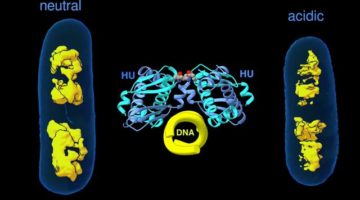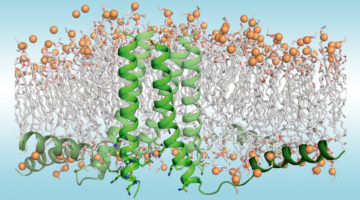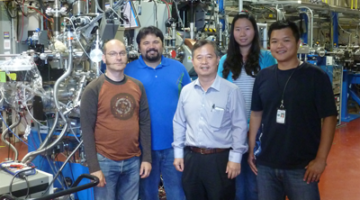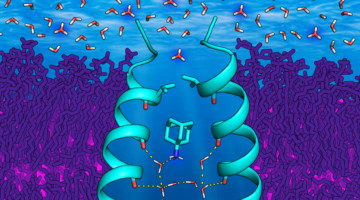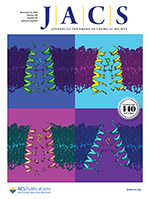Multiscale, multimodal visualization techniques at the ALS enabled researchers to clarify how proteins remodel bacterial DNA in response to stressful environments. The discovery could lead to new strategies for controlling microbial behavior and, eventually, new ways to fight bacterial infections. Read more »![]()
![]()
Study Gains New Insight Into Bacterial DNA Packing
When bacteria are put in different environments, their genes start to adapt remarkably quickly because the proteins making up their chromosomes can pack and unpack rapidly. Researchers have now imaged this process at the molecular level, a discovery that could eventually enable scientists to develop strategies to control microbial behavior. Read more »
X-ray Crystal Structures of the Influenza M2 Proton Channel Drug-Resistant V27A Mutant Bound to a Spiro-Adamantyl Amine Inhibitor Reveal the Mechanism of Adamantane Resistance
The M2 proton channel, shown with front and back monomer helices removed, is an anti-influenza drug target. Here, a bound inhibitor blocks the transport of protons through the V27A mutant channel. Read more »
Freeze Frame: Scientists Capture Atomic-Scale Snapshots of Artificial Proteins
Protein-like molecules called polypeptoids have great promise as precision building blocks for creating a variety of designer nanomaterials. In this study, rsearchers used cryo-EM, a technique originally designed to image proteins in solution, as well as x-ray scattering techniques, to characterize the structure of polypeptide nanosheets. Read more »
A Bullfrog’s Powerful Defense Against Toxic Red Tides
Working as a “molecular sponge,” a bullfrog protein known as saxiphilin provides powerful, yet little understood, protection against deadly neurotoxins produced in red tides. Crystallography studies at the ALS have clarified saxiphilin’s function, potentially enabling better ways to monitor and combat toxins in our oceans and food supplies. Read more »![]()
A Frog Worth Kissing: Natural Defense Against Red Tide Toxin Found in Bullfrogs
Researchers have discovered how a protein produced by bullfrogs binds to and inhibits the action of saxitoxin, a deadly neurotoxin that causes paralytic shellfish poisoning. The findings could lead to the first-ever antidote for the compound, which blocks nerve signaling in animal muscles, causing death by asphyxiation when consumed in sufficient quantities. Read more »
Breakthrough in Membrane-Protein Design Settles Long-Standing Debate
Scientists characterized designed membrane proteins to better understand the forces that stabilize these large, complex structures. The results necessitate a rethinking of membrane-protein biophysics and could lead to better therapies for related illnesses as well as functional membrane proteins for engineering applications. Read more »![]()
![]()
Team Chemistry Powers Industry Collaborations at the ALS
At the ALS, industry users find scientific experts and specialized facilities. Their collaboration drives discovery in a variety of fields, yielding results that are greater than the sum of their parts. Read more »
Toward a Blueprint for Anti-influenza Drugs
Researchers obtained high-resolution structures of several influenza antiviral drug molecules bound to their proton-channel targets in both open and closed conformations. The structures provide an atomic-level blueprint from which to design more effective anti-influenza drugs that can overcome growing drug resistance. Read more »![]()
![]()
Inhibitors of the M2 Proton Channel Engage and Disrupt Transmembrane Networks of Hydrogen-Bonded Waters
The influenza M2 proton channel can bind to drugs and inhibitors. The ammonium groups of these compounds form hydrogen bonds with networks of ordered waters within the channel, and the adamantyl groups sterically block the diffusion of hydronium into the channel pore. Read more »

